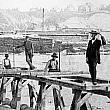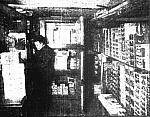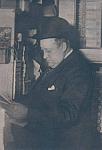Frozen Water Mains and Sewer Openings
In the early days of the city after several days of exceptionally cold weather water pipes and fire hydrants would freeze. According to an 1899 newspaper article, the frost had worked its way down through the ground and many water pipes were frozen. Bon fires were used to thaw them out. If the street was paved it required a fire to thaw out the frost in the pavement; then the fire would be extinguished in order to allow the pavement blocks to be removed.
After the blocks had been lifted the fire was started again to thaw out the ground. When the ground had been thawed as far as possible, the fire was again extinguished and the work of digging with shovel and pick was begun.
When the earth had been removed as far down as the frost permitted, then the fire was again started and the thawing process was repeated. This continued until the frozen pipes had been reached, and then the task of relieving them from their frozen condition began. The length of time required to complete the process depended on how solidly the ground was frozen and to what depth.
It was necessary to use hard wood in the work as pine did not make a sufficiently hot fire nor did it keep a steady heat. The job required at least a cord of wood to thaw out a single pipe. If a house was on the opposite side of the street from the water pipe, it was necessary to dig two holes; one next to the water main and one next to the walk adjoining the house. Even after that was done there was a chance that the frozen part might be between the two holes. When operations had once begun, the work had to be kept up over night if the thawing out was not accomplished during the day, and the fires had to be kept going. It was a great bother as well as quite an expense, and the individual had to pay the expenses instead of the city.
The sewer openings in the city also created a great deal of trouble during the excessive cold, and a large number were frozen solid. A gang on men worked around the city thawing them out. The device used was a small round steam boiler, which was placed inside another boiler. The first boiler was filled with water and a fire is started in the second boiler. In this way steam was procured and by means of a garden hose the steam was injected into the sewer. Using steam and hot water the sewer was thawed.
Excerpted from the February 25, 1899 Grand Rapids Herald, page 3
Other Cold Weather Effects
For several days during 1893 considerable difficulty was experienced with the telephone lines on Canal and Monroe Streets. Customers could not reach the central office because the frozen ground had become so charged with electricity from the street railway underground wires that the ground connection of the telephone system has been cut off. The trouble was remedied by connecting the telephone return current with the pole system.
A story about frozen ground, the streetcars, and underground wires can be found in the January 25, 1893 Grand Rapids Evening Press, page 3

 facebook
facebook






